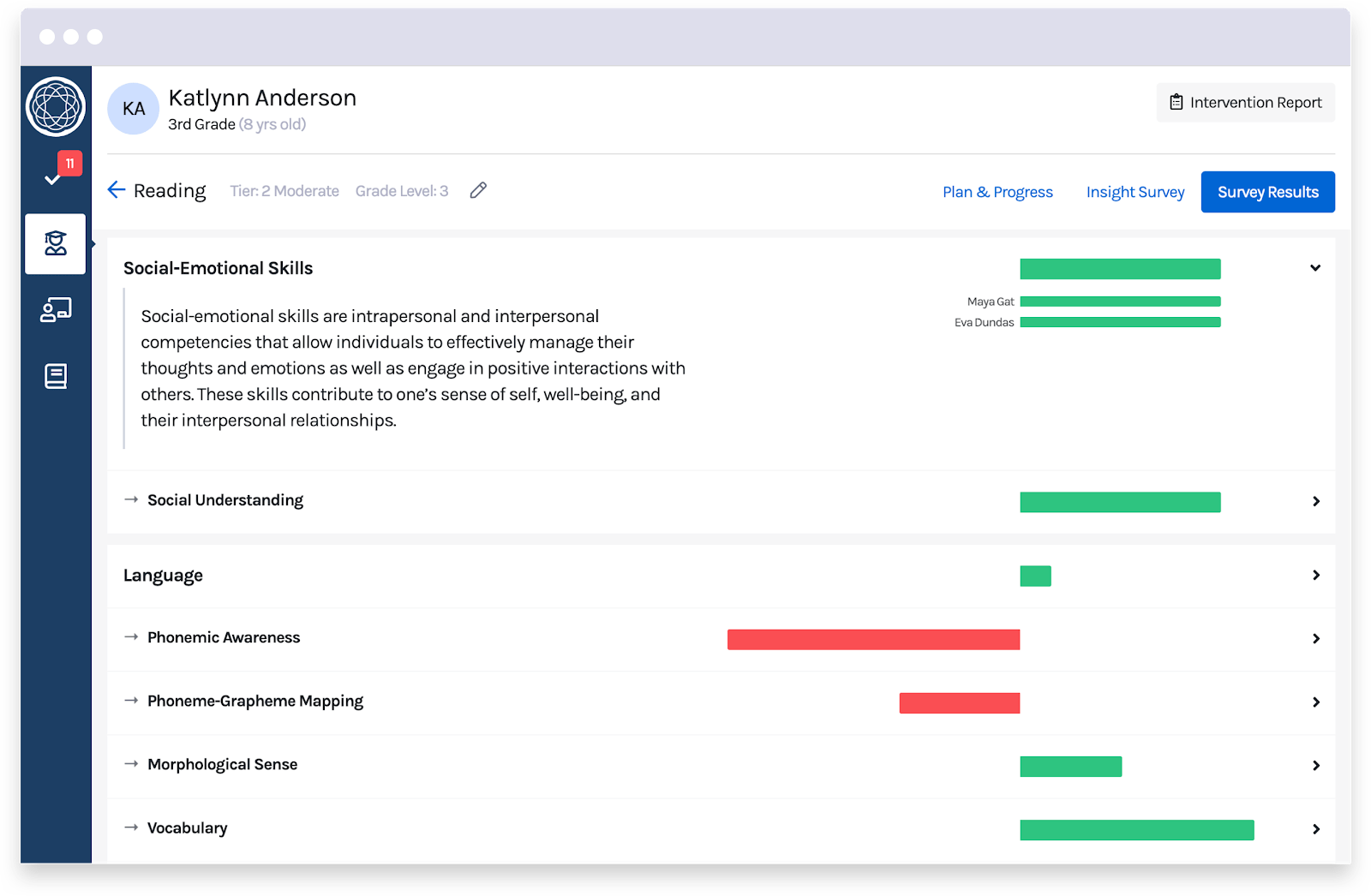
The Power of Strength-Based Instruction
We all have strengths and weaknesses, but in K-12 education, student weaknesses are often a focus of attention, while strengths fade into the background. Over the past decade, there has been a movement in education to capitalize on student strengths while using instructional practices that promote growth in areas that might need improvement.
The MTSS framework provides an excellent opportunity for educators to shift their instruction, problem-solving, and planning to include student strengths in addition to areas of needed support. Below, we outline the difference between the strengths and deficit lens, how focusing on strengths benefits all key stakeholders in education, and specific guidance on using a strengths-based approach in MTSS.
Strength vs. Deficit Lens
In many ways, an effective MTSS practice is synonymous with a strengths-based approach. MTSS is inherently a preventative model where student needs are identified, and the goal is to intervene early to prevent students from falling further behind. But, educators can still get stuck focusing on student deficits, even when trying to support students within an MTSS framework.
There are different definitions, interpretations, and degrees of strengths-based instruction. Still, the critical underlying component is that educators use a strength-based approach to view and analyze student learning and development instead of focusing on student deficits. By undertaking this strength-based lens, all educators have an articulated effort to focus on student strengths and development of skills, use positive language, and highlight growth areas.
Benefits of Focusing on Student Strengths
Strength-based instruction and learning benefits teachers, students, parents/guardians, and the community. Focusing on student strengths is motivating for students. It can also help them develop a growth mindset, where they see themselves as having the ability to grow and improve across all areas, rather than seeing their skills and abilities as fixed traits. It is also essential for students' sense of self-efficacy to help them become aware of their strengths and the areas within the school they are good at and enjoy.
STUDENTS
Highlighting strengths can help students understand the areas where more growth is possible. For example, if a student excels in athletics, drawing a comparison between applying the same focus they utilize when competing in a sport to an academic area of need can help the student to finish a school project or progress toward an educational milestone.
TEACHERS
Strength-based instruction can also motivate teachers by bringing their attention to things their students are good at and where they have grown. This approach can also help teachers become more aware of student strengths and the skills they should focus on more during instruction. Understanding students' strengths and areas of need is a vital part of MTSS, where skill-based goals should be the basis of all intervention plans. Understanding strengths helps educators develop strategies and support plans that will be effective for specific students. For example, if a student works well with peers and has strong social skills, a peer-based mentoring program or intervention may be impactful.
|
From the classroom: I once had a student that was a phenomenal artist. That’s all she wanted to do — draw — and nothing else. She struggled to read and engage with the class as we discussed a novel. I wondered if this student might be more inclined to be involved if she could participate in a way that made sense to her. So I offered to let her draw a scene from the reading as a way to explain what she understood of the story. Even further, I asked if I could use the drawing she created to help other classes understand the story. Sure enough, this student was excited to participate in this way and was drawn into the discussion! - Larissa Napolitan, former middle school teacher and instructional coach |
PARENTS
It can be overwhelming and discouraging for caregivers to only hear about how their child is struggling in the classroom. Sharing strengths with families shows that teachers see their child as a whole person and are not targeting certain students based on demographic characteristics or personality traits. Sharing both strengths and areas of growth with parents can give them hope and help with motivation to engage with their student’s education and hold high expectations for the future.
➡️ Related resource: Restorative Practices and How They Fit into MTSS
3 Tips for Putting a Strength-Based MTSS Approach into Practice
There are several ways that educators can embed a strengths-based approach into their existing MTSS framework and practices. An excellent place to start is during MTSS grade-level meetings, where teachers often review student data and make decisions about plans and next steps.
TIP #1: Educators should make a consistent and conscious effort to use positive, strength-based language when discussing students.
If students are struggling, try to discuss the skill that needs development and not just the deficits or problems they are displaying. Teachers should also make an effort to discuss strategies and approaches that have been effective or might be effective, rather than only things that haven't worked.
|
From the classroom: Have you had students who love to lead and learn but have executive function struggles and are often off-task? In one such case, I was able to engage the student by training him to manage the notes slides on the computer as I presented the lesson. He loved to be an assistant and remained engaged in the lesson, answered questions, and really cared whether he was on the right slide as the class took notes. I shared this strategy with the other teachers, and soon he was assisting teachers in other classes and couldn’t wait to be a teacher's aide. - Larissa Napolitan, former middle school teacher and instructional coach |
Another shift in language should be the way that MTSS tier levels are discussed and described. Within MTSS, tiers define the level of support needed in a specific area and do not define the students themselves. For example, instead of saying, "Tommy is a Tier 2 kid," say, "Tommy needs Tier 2 support in reading to be successful." This shift in approach should be reflected during meetings, in written/required forms, emails, documentation, and all other forms of communication.
TIP #2: Whenever possible, schools and districts should use a strengths-based assessment approach to measure student competencies and growth.
Using this approach is especially important when assessing students' social-emotional and behavioral skills. Schools that rely on deficit-based behavior measures, such as the number of behavior incidents, suspensions, or absences, will likely have difficulty identifying the skills needed to actually reduce some of these problematic behaviors.
Many deficit-focused assessments/measures may lead to biased reporting, as they are based upon student demographic characteristics, such as race, ethnicity, and special education status. Social-emotional assessments that highlight student strengths, such as the DESSA, can help protect against some of these biases by bringing teachers' attention towards strengths. In addition, using academic and social-emotional assessments that measure multiple areas and subdomains can help teachers identify skills that students may be doing well in, even if their overall scores signal a need for support.
TIP #3: SMART goal setting is one of the most important and most challenging components of a strengths-based approach in MTSS.
SMART goals for students receiving Tier 2 and 3 levels of support should always be strengths-based and articulate the specific skill or behavior that will be the focus within the intervention plan.
Goals should be stated in positive terms and describe the desired behavioral outcome or academic skill. For example, instead of saying, "Mia will stop calling out" or "Michael will stop skipping unknown words," the goal should state that "Mia will raise her hand when she has a question" or "Michael will sound out unknown words." Having these types of positively worded goals helps educators measure progress and focus on the specific skill they should be working on with students.
Conclusion
The shift towards a strengths-based approach in education, especially within the MTSS framework, holds immense potential to transform the educational experience for students, teachers, and parents. By recognizing and harnessing students' strengths while also addressing weaknesses, we can inspire and motivate students to grow in all areas.
KEY TAKEAWAYS:
A strengths-based approach:
- Fosters a growth mindset in students and helps them realize their own potential
- Helps teachers tailor instruction to meet their student's unique needs
- Engages parents in a more positive partnership for their student’s success
ADDITIONAL RESOURCES:
- The Social-Emotional Learning Guide
- 5 Resources for Building Positive Family Relationships
- 6 Steps To Using Data To Develop Classwide SEL & Behavior Strategies
- How a School Utilized MTSS to Build Trust & Positive Communication With Families

Dr. Essie Sutton
Essie Sutton is an Applied Developmental Psychologist and the Director of Learning Science at Branching Minds. Her work brings together the fields of Child Development and Education Psychology to improve learning and development for all students. Dr. Sutton is responsible for studying the impacts of the Branching Minds on students’ academic, behavioral, and social-emotional outcomes. She also leverages MTSS research and best practices to develop and improve the Branching Minds platform.
Related Posts
Tagged: SEL and Mental Health, Academics






Comments (0)